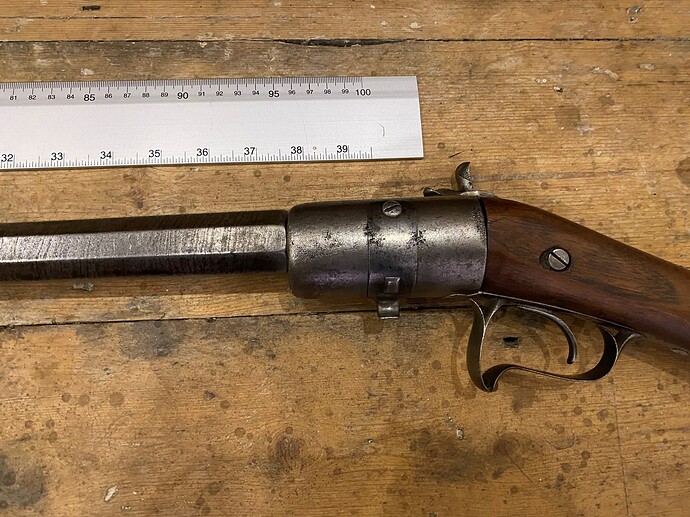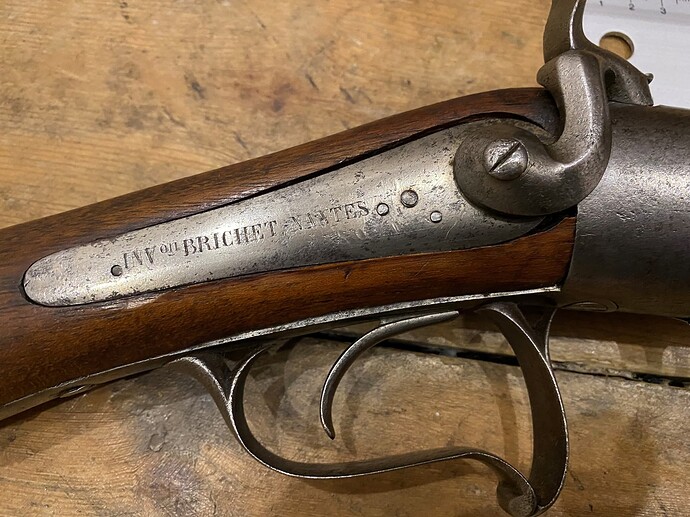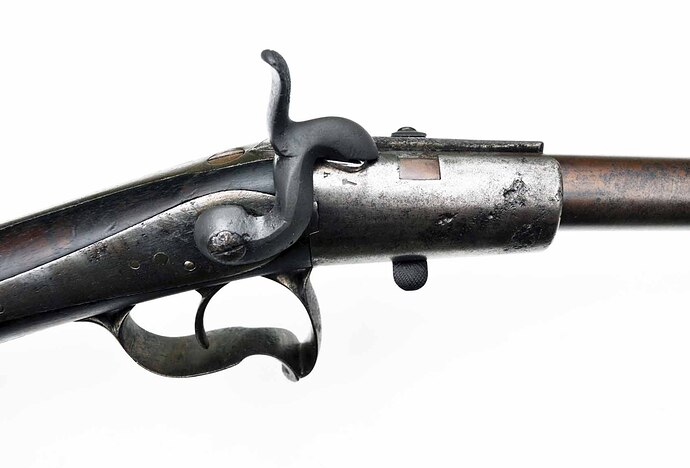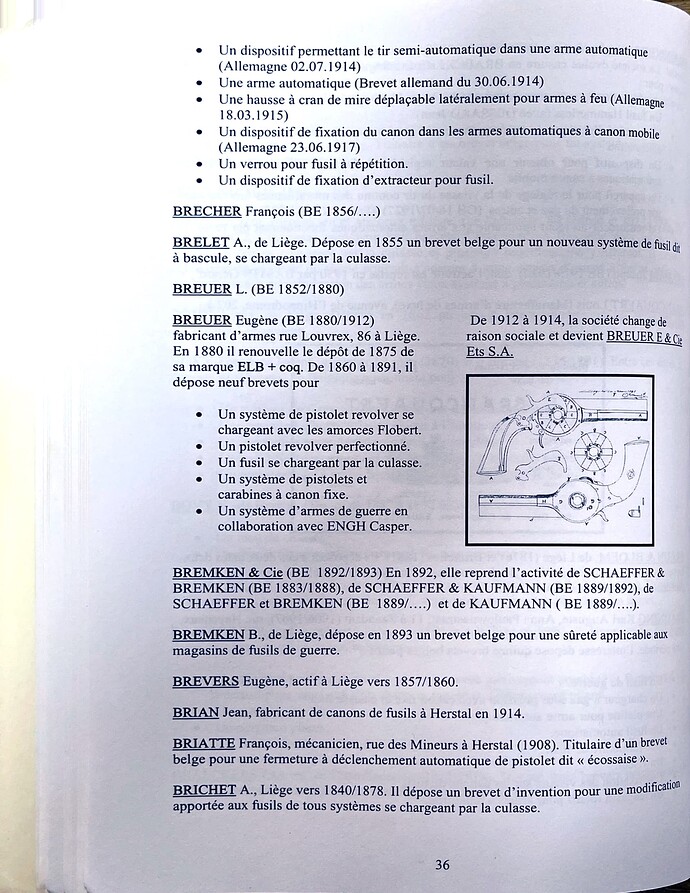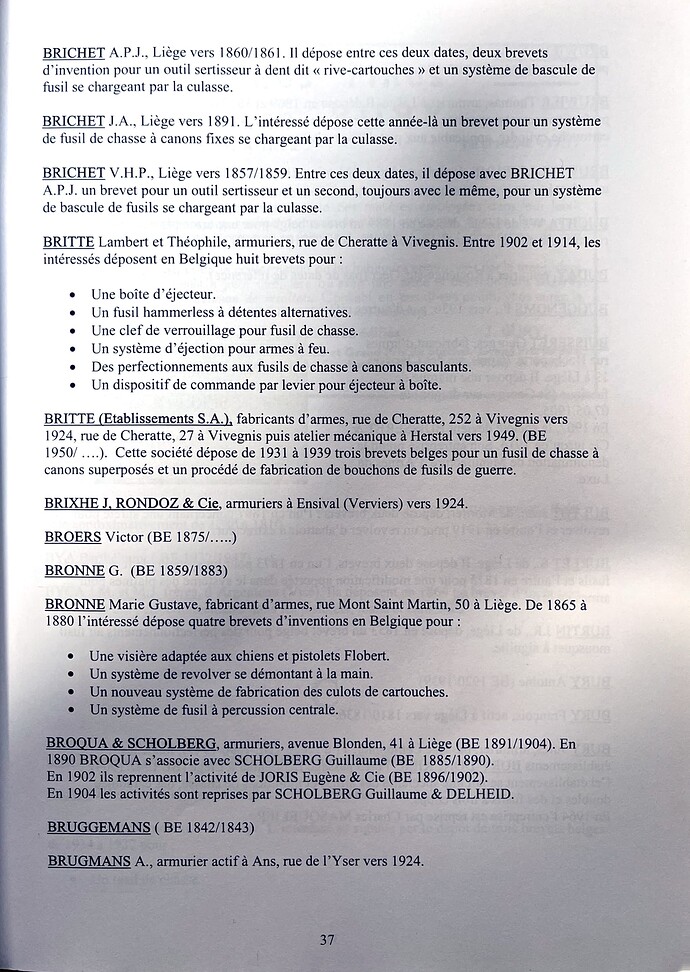Hi,
I wonder if anyone can help, with any information on the following gun?
It’s a 10 bore Pinfire, takedown fowling gun, signed BRICHET, NANTES, there’s no visible serial number, I guess its around1860, It has a heavy octagonal to round 40 1/2in. twist iron barrel detaching from the cradle-form plain action with a twist and pull motion released via a catch, plain back-action lock marked ‘INV.ON BRICHET NANTES’, carved rear-sight channel to back of action, walnut butt-stock, flat-fronted trigger guard and no provision for fore-end.
It seems a very strange design to have to remove the barrel to put in a cartridge, there is no extractor, and you have to manually remove the cartridge, from the barrel.
The gun appears to have a Belgium provisional proof mark, and 19mm stamped on the barrel, it also has a third proof mark, that looks like the letter Y below a crown, I am guessing this is a final proof mark, but I couldn’t find this mark in lists of Belgium or French proof marks.
Hopefully, this is enough pictures to help identify it, as a new contributor, I was limited to the number I could attach.
Have had exactly the same in my collection
That’s great, do you know anything about it’s history, or who actually made it, & where & how many were prduced?
Regards
Martin
I’am not at home actually and have some answers for you but not all of them
Hi,
Any information would be great, I’m not in any rush, & am really grateful that you are taking the trouble to reply 
Regards
Martin
Stoeckel mentions a Brichet in Nantes, Loire-Atlantique, at 21 Rue de la Fosse for 1855. The proof marks seem to be Belgian “bench proofs” (ELG*) and inspector’s mark (Crown over Y). That is all I can tell you. Good luck!
That’s very helpful, thank you.
Regards Martin
Yes that is true, but I didn’t find any connection between the French and Belgium branch…but both branches are gunsmithing … it’s a little world so its possible that they are familly, as I see on your picture …
They Y with his crown is the inspector’s mark of the proof bench of Liège in us before the 1st January 1877.
the french branch filed several patents between 1856 and 1860.
the belgium branch filed also patents but for that I have to look in some books … 
Thanks, that’s really helpful & useful information, & I really appreciate the amount of time you have taken to answer my questions.
Regards
Martin
You will have to translate it, this is a part of the research about the Brichet familly I made a few years ago when I tried to identify my Brichet shotgun .
Un peu d’histoire et de généalogie :
Alphonse Pierre Jacques Brichet est né en la commune de Precigné dans la Sarthe le 10 décembre 1824.
Fils de Pierre Brichet, boulanger et de Modeste Girard.
Installé en tant qu’armurier à Nantes après 1851 et avant 1853 au 20, rue de la fosse et y travaille avec son frère Victor.
Selon les registres de recensement de la population de 1856, l’habitation de la famille Brichet est située au 1, passage Pommeraye qui forme l’angle avec le numéro 20, rue de la Fosse.
Personne de même nom n’y est recensé en 1851.
Alphonse se mari une première fois le 22 janvier 1853 en la ville de Nantes avec Alexandrine Cécile Matran, née le 3 novembre 1833 dans cette même ville.
Sur l’acte de mariage, Alphonse, indique qu’il est domicilié au 20, rue de la Fosse.
Un premier fils, Alphonse Maximilien, est né le 22 juin 1854.
La mère d’Alphonse, s’installe dans la ville d’Angers entre 1853 et 1858.
Le 20 décembre 1856, Alphonse Brichet dépose le brevet n°30158 pour un fusil à bascule se chargeant par derrière.
Un deuxième fils, Maximilien Jules Victor, est né le 2 février 1857.
Sa femme Alexandrine décèdera, le 4 mars 1857, très probablement après des complications suite à l’accouchement de Maximilien.
Le 14 décembre il dépose un certificat d’addition au brevet n°30158.
Alphonse se mari une deuxième fois avec la sœur de sa première épouse, Elisa Matran, le 27 juillet 1858, née à Nantes le 27 août 1837.
De ce deuxième mariage nait, le 21 juillet 1859, sa fille Anaïs Alphonsine et le 8 janvier 1864 son fils Camille.
Le 6 mai 1859, Alphonse dépose un deuxième brevet, le n° 40804, pour un fusil à culasse mobile, se chargeant par la culasse.
La même année, le 21 octobre, il dépose un nouveau brevet, le n° 42512, concernant un système de fusils doubles et simples, principalement se chargeant par le tonnerre et ce découvrant par le moyen de la sous-garde.
En 1867 il participe à l’exposition universelle de Paris.
Le 9 mai 1873, il déclare la mort de son fils, Alphonse Maximilien, fils d’Alexandrine, âgé de 18 ans lui aussi armurier.
Maximilien Jules Victor prendra la suite de son père en tant qu’armurier à la même adresse.
Alphonse Pierre Jacques décède le 14 mai 1911 en son domicile suivi par Elisa le 8 juin de la même année.
Maximilien décède le 4 févier 1915 et c’est son fils Georges Louis Alphonse, né le 15 mai 1895 qui prendra la suite de l’armurerie.
A la mort de Georges c’est Jean René à reprendre le flambeau de l’armurerie.
C’est finalement Jean René qui mettra un terme vers l’an 2000 à cette saga de 150 ans faute de successeur.
Sources :
- « Qui est Qui » de Jarlier Tome 1 page 78
- www.geneanet.com « Brichet – Nantes »
- Archives de la ville de Nantes www.archives.nantes.fr .
- Les registres de l’INPI.
Thanks, that’s absolutely brilliant, I’m really excited to read it😀
I don’t speak any French, so haven’t got a clue what it says, but fortunately my wife speaks fluent French, so she will translate it for me.
I really appreciate your help.
Regards
Martin
Thanks, that’s absolutely brilliant, I’m really excited to read it😀
I don’t speak any French, so haven’t got a clue what it says, but fortunately my wife speaks fluent French, so she will translate it for me.
I really appreciate your help.
Regards
Martin
Just in case anyone else wants an English translation, of the very useful Brichet family history….
Alphonse Pierre Jacques Brichet was born in the town of Precigné in Sarthe on December 10, 1824.
Son of Pierre Brichet, baker and Modeste Girard.
Installed as a gunsmith in Nantes after 1851 and before 1853 at 20, rue de la Fosse and worked there with his brother Victor.
According to the population census registers of 1856, the Brichet family’s home is located at 1, passage Pommeraye, which forms the corner with number 20, rue de la Fosse.
No one with the same name was listed there in 1851.
Alphonse married for the first time on January 22, 1853 in the city of Nantes with Alexandrine Cécile Matran, born on November 3, 1833 in the same city.
On the marriage certificate, Alphonse indicates that he is domiciled at 20, rue de la Fosse.
A first son, Alphonse Maximilien, was born on June 22, 1854.
Alphonse’s mother settled in the city of Angers between 1853 and 1858.
On December 20, 1856, Alphonse Brichet filed patent n°30158 for a tilting rifle loading from behind.
A second son, Maximilien Jules Victor, was born on February 2, 1857.
His wife Alexandrine died on March 4, 1857, most likely after complications following the delivery of Maximilien.
On December 14, he filed a certificate of addition to patent n°30158.
Alphonse married a second time with the sister of his first wife, Elisa Matran, on July 27, 1858, born in Nantes on August 27, 1837.
From this second marriage was born, on July 21, 1859, his daughter Anaïs Alphonsine and on January 8, 1864 his son Camille.
On May 6, 1859, Alphonse filed a second patent, No. 40804, for a bolt action rifle, loading from the breech.
The same year, on October 21, he filed a new patent, n° 42512, concerning a system of double and single rifles, mainly charging by thunder and uncovering by means of the sub-guard.
In 1867 he participated in the Universal Exhibition in Paris.
On May 9, 1873, he declared the death of his son, Alphonse Maximilien, son of Alexandrine, aged 18, also a gunsmith.
Maximilien Jules Victor will take over from his father as a gunsmith at the same address.
Alphonse Pierre Jacques died on May 14, 1911 at his home, followed by Elisa on June 8 of the same year.
Maximilien died on February 4, 1915 and his son Georges Louis Alphonse, born May 15, 1895, took over the armoury.
On the death of Georges, it was Jean René who took up the torch of the armoury.
It was finally Jean René who put an end to this 150-year saga around the year 2000 for lack of a successor.
Thanks for that, I didn’t realise there was a translate button 


